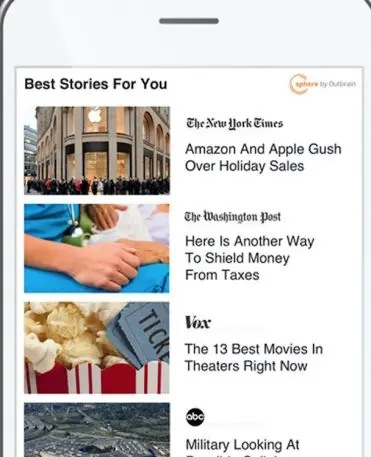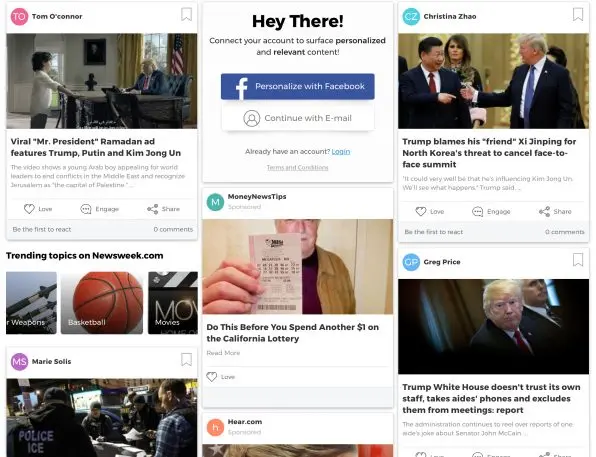When Facebook announced in January that it would soon de-emphasize posts from publishers in users’ news feeds, it felt like the last betrayal in a bad marriage. Referral traffic to publisher sites from Facebook had already dropped 50 percent in the past year (see chart below), and things were only going to get worse.
They’d stay together for the followers, sure. But things would never be like they were just a couple of years ago, when Facebook seduced publishers with the promise of building a blossoming business together within its walls.
In the months since, publishers have been focused on rediscovering themselves. They’ve talked of building a better experience on their sites and stronger relationships with readers, refocusing after chasing scale on Facebook for years.
“Most publishers abandoned reader revenue and thought they’d build revenue on scale, and thought things would be great,” Raju Narisetti, the recently departed CEO of Gizmodo Media Group, explained on a panel at the International Journalism Festival last month. “But it hasn’t been great.”
But for some publishers, another question has emerged: Why was Facebook able to drive clicks at such a torrential pace? And what could they learn from its techniques?
Facebook-ifying the web
The past year has seen an intriguing wave of technology that allow publishers to take the most effective parts of Facebook’s News Feed and apply it to their sites. This technology has come from an unlikely source–content-discovery engines like Outbrain, Taboola, and RevContent.
The trio of competitors are responsible for the vast majority of the “recommended” sponsored content under articles on publisher sites. These sponsored spots are a major source of revenue for publishers, but sometimes derided by media critics for the sketchy quality of their content.
For years, they’ve all also competed with Facebook’s ad business, which remains one of the most effective ways for brands and publishers to drive paid clicks to content. And all three companies came to a similar conclusion: What if they could help publishers create an experience on their own sites that resembled Facebook’s feed?
From a user-experience perspective, there are two elements that make Facebook such an effective delivery mechanism for content. The first is the feed itself–an infinite scroll of fast-loading content modules that’s inherently addictive. The second is personalization; Facebook’s algorithm knows what you click on and then serves you more of the same.
Outbrain, Taboola, and RevContent all track billions of clicks each month, and can track people’s content preferences in a similar way. And they’ve all launched tools that allow publishers to turn their mobile sites into a Facebook-lite experience through an infinite feed of personalized content. Here’s what each offers.
Taboola: Feed
Just a year after launch, Feed is already beginning to transform Taboola’s business. It’s a card-based system that allows publishers to create an infinite stream of content below an article. For Taboola CEO Adam Singolda, the most exciting part is that this content isn’t limited to articles. Feed allows publishers to include myriad content formats–articles, native video, and even weather cards via The Weather Channel.
According to Singolda, roughly 20 percent of Taboola’s revenue now comes from Feed. That’s because the new technology allows for autoplay videos in the feed natively, as Instagram and Facebook do.
“We now stream 100-130 million video views every single day,” he explains. “I believe we will be at a billion video views a day, giving us an opportunity to give $20 billion of video budgets to go into the open web and not only YouTube ad Facebook.”
Feed is most appealing to publishers looking for a monetization boost, taking a page from the playbook that’s allowed Facebook to capture nearly 20 percent of the total digital ad market. It also features carousels of content, which lets publishers generate multiple video views from just one spot in the crawl.
HuffPo Korea, for instance, saw a 40% increase in RPM (Revenue Per Thousand Impressions) and a 60% percent increase in CTR (Click-through-Rate) after adopting Feed. In other words, Feed is allowing the site to generate more revenue per pageview, while also increasing the rate in which people click on additional content, whether it’s organic HuffPo content or sponsored ads.
Outbrain: Sphere and SmartFeed
In February, Outbrain announced two new tools: SmartFeed and Sphere. SmartFeed is extremely similar to Taboola’s Feed, in both name and features–minus the carousel and weather cards. Sphere is much more interesting, and may appeal the most to publishers looking for high-quality replacements for traffic lost by Facebook’s algorithm change.
Sphere is an invite-only content recommendation network, fittingly launched on Valentine’s Day, which allows publishers to show each other love. The appeal is that they can buy and sell traffic within the network without worrying about low-value sponsored content (“10 Celebrity Sideboob Shots You Just Have to See!”) tainting their sites. CNN can rest assured that it’s recommending a high-quality article on a Meredith publication instead of a sketchy post on brainpill.com.

If a piece causes a consumer to leave a site immediately after clicking on it, that piece gets downgraded in the algorithm. If the user clicks on a piece and then subsequently clicks on a second article, it gets upvoted and shown more frequently.
This is a stark departure from how every other advertising network works. Usually, ad placement goes to the highest bidder. Sphere mitigates this by creating a fixed CPC (cost per click) of $0.015. Publishers collect 100% of the revenue from the first click. Outbrain only takes a cut if the reader clicks on another article. According to Crenshaw, the $0.015 CPC is is “very much in line and slightly favorable to what [publishers] can get with Facebook.”
As for the the way Sphere intermingles content from media companies, “we want to build a world where premium publishers grow each other,” he adds. “When we talked to them two years ago, publishers said, ‘No, that’s my competition.’ Now they see platforms as the competition.”
RevContent: Engage.im
The newest of the tools, RevContent’s Engage.im, takes a significantly different approach, allowing users and publishers to recreate the Facebook experience. The tool integrates into a publisher’s content-management system (such as WordPress) and commenting infrastructure (Disqus, for example), allowing readers to comment directly on the content module, much like they would with Facebook. Through a Facebook integration, users can pull in their Facebook data to personalize content, and then select topics they’re interested in to customize it further.
According to RevContent CEO John Lemp, publishers have complete control over the tool and can choose to feature just their own content, or include sponsored content as well.
The early results are promising. The tool, which was announced in March, has been live on Newsweek’s site for several months. According to Newsweek CEO Dev Pragad, “Traffic from Engage.im performs at 531 percent higher average time on site than social, resulting in a significantly improved user experience and better engagement with our content.” Newsweek has seen a 4-5X increase in engagement before personalization, and an 11X increase in engagement afterwards, as measured by time spent with content.

“We want to build a personal experience that allows our audience to customize their site to their interests and create a space where they can engage with our content to establish a deeper relation,” explains Pragad.
Newsweek has spent the year in an “insane crisis” this year following a raid by the Manhattan DA over financial ties with fringe religious groups, the firing of top editors investigating the story, the hiring of an executive who had been accused of sexual harassment, and finally, an alleged ad fraud scheme in which the company reportedly bought fraudulent traffic via hidden pop-ups on pirate streaming sites. (Just writing that sentence was exhausting.) Its site’s remake with the Engage tool could be considered, most generously, as an opportunity to create a new experience and identity–assuming it can resist allowing through the sketchier sponsored content that can appear in content recommendation engines.
Luckily for RevContent, Engage–which is still in beta–is live and working on several publisher sites. RevContent shared engagement stats from two additional major news sites and one entertainment site. The publishers saw a 175% increase in time on site, 50% increase in pageviews per session, and a 28% decrease in bounce rate as the result of using the tool.
The open web: a new hope
For years, the share of users’ time shifted more and more into the walled gardens of Facebook and other apps. In turn, the media industry has been haunted by the fatalistic sense that the open web is dying. That might be changing.
After all, what’s likely driven most users from the web to apps is not their inherent appeal. Rather, it’s that the experience on most mobile sites sucked. Publishers, with poor formatting and intrusive ad formats, were the among the worst offenders. Instead of fixing that experience, many tried to curry favor with platforms instead.
Each of the new tools from Taboola, Outbrain, and RevContent paints a unique picture of what a better open web might look like on publisher sites. It’s a vision of transformation for these companies as well, which could find a second life beyond the buying and selling of link clicks.
Singolda, Taboola’s CEO, envisions Feed as an operating system that allows fast-loading, personalized content from myriad sites that loads instantaneously, similar to Google’s AMP technology. He predicts that in just a few years, the open web will flow so quickly and seamlessly from page to page that we’ll stop thinking about web pages as standalone entities.
Meanwhile, Lemp, RevContent’s CEO, believes that creating a robust Facebook-like experience is essential, and that a feed isn’t enough. “I compare it to having your toddler get into his power wheel and have it go into a race on the street against a Tesla. They’re both electric cars, but the Tesla is going to win.”
Outbrain, while embracing the same feed principle as Taboola, is instead betting that the quality of the content makes all the difference—that the future lies in empowering publishers to create a better content ecosystem together, optimized for deeper engagement. Ultimately, a big part of that challenge is prompting publishers to think like marketers and focus on the lifetime value of users, instead of optimizing for revenue at the pageview or ad-unit level.
“The currency is going to graduate from being clicks and attention to lifetime value and loyalty,” said Crenshaw. “The Jeff Bezos line is to think about what won’t change, not what will change. What won’t change is publishers will always have to be thinking about what to show next–to create a guided journey for users.”
And if publishers are able to do that as well as Facebook, now that their romance with the social network is over? Well then, they might have found the perfect rebound: readers.
Joe Lazauskas is the the head of content strategy at Contently and co-author of The Storytelling Edge, a new book about the science of storytelling and how to use it to transform your business.
Recognize your brand’s excellence by applying to this year’s Brands That Matter Awards before the early-rate deadline, May 3.
